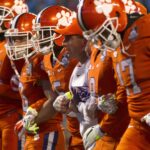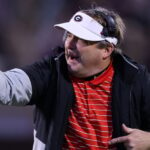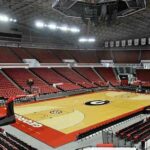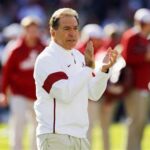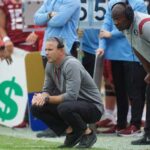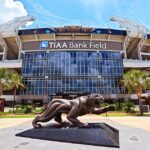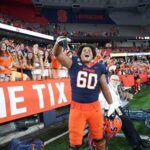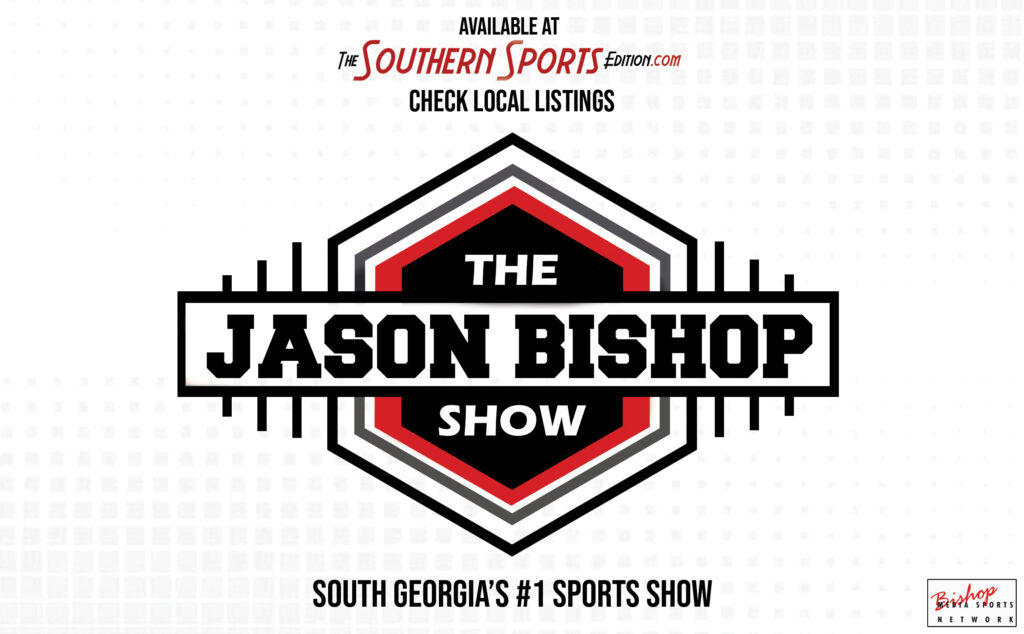Robert Craft
ACC All Gone?
 By: Robert Craft
By: Robert Craft
TheSouthernSportsEdition.com news services
The SEC and Big Ten (right now) don’t want to expand and steal someone from the ACC or Pac-12, both commissioners Greg Sankey and Tony Petitti have stated that publicly.
The potential implosion of the ACC or Pac-12 might change that. If the Pac-12 collapses or big names like North Carolina, Florida State, Clemson and the like find a way out of the ACC Grant of Rights, the Big Ten and SEC would be concerned about the other scooping up another big market name, and that changes the dynamic.
Sankey has maintained that the SEC only added Texas/Oklahoma because the schools approached the conference and SEC would have been foolish to pass. (And yes, Notre Dame is the only obvious TV additive right now if you’re the SEC or Big Ten, sorry).
If I’m the ACC, increasing my value is top priority, therefore I wouldn’t fall far behind the Big Ten and the SEC, and keep it that way until at least the end of the decade. Smart conferences will already find new revenue streams in a new and ever-evolving market.
Would a smart conference stay in contact with the Pac-12? Would some sort of scheduling alliance or partnership be available? An eye on the Pac-12; if anyone follows Colorado out the door, it could lead to total collapse.
Already, Florida State, Clemson and others have made it clear that they believe they deserve more (money). Do they see themselves splitting the pie by another four slices? Is it evenly shared? Probably not. Could you do a tiered revenue split and add a western wing? I know things are never as simple as they sound on paper, but I’d explore any option to preserve the brightest future for the program.
Of course, there is always the possibility that someone challenges the ACC’s grant of rights and tries to exit the league. Florida State has a virtual board of trustees meeting soon.
The Seminoles would have to give notice of their withdrawal from the ACC by Aug. 15 in order to compete in a new league by fall 2024 (where would they go? How much is the exit fee?).
If the ACC breaks open, we’ll have a different conversation. The ACC could keep its current membership and become an aggressor in the media profit landscape if 1) they want a fight; and 2) they don’t open up an escape for FSU or Clemson or anyone to get out of the grant of rights.
The ACC corner of realignment is the most intriguing off-field action. The more I watch, the more questions surface. The result of this conflict will set the tone and trajectory for the future of a historically competitive conference.
Walking the Plank
 By: Robert Craft
By: Robert Craft
TheSouthernSportsEdition.com news services
There was no way for the Bucs to find another quarterback who could command the offense the way Brady did. So, they chose to give the gifted but unsuccessful Baker Mayfield a chance and allow room for the development of second-year passer Kyle Trask.
The Bucs will be dependent on much more than whoever is throwing the ball. They will need solid coaching, an improved running game, dependable receivers, and a better defense. It will take many to replace the greatest in the history of the game.
I feel like the Bucs, without Tom Brady, have fallen off the face of the earth. Has there ever been a team that went from winning a Super Bowl two short years ago to fighting for relevance within its own division this fast? (OK, let’s leave the Rams out of this.)
Let’s start with the reality that Tampa was somewhat limited by salary cap issues they knew would come due (such as $35 million in the wake of Tom Brady’s retirement). Releasing running back Leonard Fournette ($5 million) and several others totaling $75 million in dead money … yikes. Nothing like biting the bullet for 2023- and Tampa Bay has lead teeth.
The Bucs defense is easiest to trust, and they will have to sustain dominance to give their tender offense the chance to score. Overall, they ranked in the top half of the league in most defensive stats last season, being top 10 in sacks and third down stops.
Devin White’s performance has tailed off a bit since his All-Pro season in 2020, nevertheless he is a supremely gifted linebacker and at 25 he probably has not yet played his best ball.
White should be more motivated than ever. He reportedly requested a trade in the offseason because he wants his contract reworked.
The Bucs exercised the option year of his rookie contract and he will be a free agent after this season, barring an extension or tag.
White knows the cost of middle linebackers has gone up in the last year with Roquan Smith, Fred Warner, and Tremaine Edmunds signing new deals. White and the defense need to play at an extremely high level for the Bucs to have anywhere close to a successful season.
I like GM Jason Licht’s philosophy of drafting BIG with his top three picks this year — two front-seven players on defense and an offensive tackle. Add free-agent acquisition Greg Gaines from the Rams at defensive tackle, and this group has gotten a nice makeover on a limited budget.
Also, it’s year 2 under head coach Todd Bowles, and roles should be defined more clearly after the awkward departure of Bruce Arians last offseason.
On offense, I struggle with Baker Mayfield. He is on his fourth team since being the first pick in the 2018 draft. I have less faith in Kyle Trask.
The Bucs’ inexperience at running back and lack of depth in the perimeter leave me with more questions than answers for this offense.
Today, I’m giving them the benefit of the doubt as the division winner from 2022, even if it was with an 8-9 record.
At least they have that Super Bowl trophy to shine up if all else fails. If the future’s looking bad, why not live in the past Tampa Bay?
Moving On Up
 By: Robert Craft
By: Robert Craft
TheSouthernSportsEdition.com news services
For a team coming off a playoff win in 2023, Jacksonville’s handling of prosperity might be an issue. This season, expect the Jaguars to be in hunting mode.
Being a hunter is a mindset that shapes messaging within a team’s development and morale. Finishing last season in the top 10 in points per game and third down conversion is hefty proof of promise.
In addition, their franchise quarterback has shown serious advancement in his playmaking ability; a good QB1 should make most folks rest easy in Duval County, considering what they’ve been through the last decade. Their competitive fire should have them targeting the gap between them and the AFC elite – this year that target is realistic for Jacksonville.
The Jags defense has ‘more hard to block’ players than any other team in the league. General Manager Trent Baalke has shown an impressive management style by adopting the one simple philosophy that analytic teams despise: drafting the best player available when it’s time to select.
The Jags were known for being driven by numbers and analytics when team building in the past. This season’s build is proof that old-fashioned eyeball evaluation (football sense, some call), can pair successfully with the objective statistical approach that Jags owner Shad Khan instituted upon acquiring the team.
Jacksonville has multiple pass rushers, but outside linebacker Josh Allen and defensive lineman Travon Walker are elite.
At the inside linebacker spots, they have athletic ability that most teams only dream about, with under-the-radar Foyesade Oluokun and 2022 first-round pick Devin Lloyd. Both fly around at a frantic pace, but once the game slows down for them, they will rival 49ers Pro Bowler Fred Warner.
My worry is that the results Jacksonville posted in 2022 are much less than the individual parts are capable of. They do lack some cover skills in the secondary as evidenced by their ranking of 29th in the league in getting off the field on third downs, and their 35 sacks as a team, which tied for 25th most, is mind-boggling.
These are unacceptable results for a team that blitzed on a division-high 25 percent of snaps.
This defense needs to come together in its second year under coordinator Mike Caldwell. The rise of the Jags to a level needed to compete with the Bills, Bengals and Chiefs is predicated on getting more out of its talented crew on defense.
Oh yeah, and if I had a couple of extra bucks, I might just throw it down for giggles on Walker as the AFC Defensive Player of the Year. He’s that good.
With the four-game suspension Cam Robinson for violating the league’s policy on performance-enhancing substances, the Jaguars must find way to protect their franchise quarterback.
This team will go as far as Trevor Lawrence can take them — and there’s potential for that to be pretty far — but it’s asking a lot of him to outduel some of the AFC’s premier quarterbacks if the defense doesn’t generate enough pressure.
South Beach Swag
 By: Robert Craft
By: Robert Craft
TheSouthernSportsEdition.com news services
The decision-makers in Miami must be after my heart.
They’re building an offense that can score from anywhere on the field with big-play ability and game-changing speed that is both fun and exciting.
It got even more explosive with this year’s draft addition of Devon Achane, their new third-string running back.
The problem is the Dolphins ran the ball less than every team in the NFL last year except for one (the Buccaneers). Teams who dominate run the ball well.
For Miami, this standing has to change. Mike McDaniel came to Miami with a reputation of being a run game specialist; he needs to put that into action.
The Dolphins also ranked in the bottom third offensively on third-down conversions in a league that is all about matchups and third downs.
A healthy QB1 should help the conversion rate improve, but that’s a big ask with Tua Tagovailoa’s injury history. What would make me sleep easier as a Dolphin decision-maker is the addition of Mike White as QB2.
I am a believer in White’s skill and mindset. This is a big upgrade over Teddy Bridgewater. In all likelihood it’s not a question of whether he will play, but when?
On the other side of the ball the defense has undergone another serious facelift. Playmaking but undersized David Long was signed from the Titans to play inside linebacker, and salary cap-heavy defensive back Jalen Ramsey was added for a discount from the rebuilding Rams.
The Fins’ blitz rate was third most in the league in 2022, and they played some form of man coverage 39 percent of the time, second most in the league.
They are taking on much risk for the results they received: 24th in points allowed per game, 24th in stopping opponents on third downs and 28th in QB rating allowed (95.3).
Combine these bottom-feeding numbers with a turnover margin of minus -7, and the Dolphins were lucky to get in the playoffs last year. They gave up 113 more points than the Bills for the season. If that doesn’t improve, they are going nowhere.
A large concern across the board is the depth and quality of the offensive line protecting Tua Tagovailoa. An O-line that can’t open up running lanes remains a concern for any pro team.
The Miami Dolphins have a Super Bowl-caliber roster with health at quarterback and a more potent rushing attack, so improved play from this new unit is paramount.
Isaiah Wynn was a smart signing; he can fill in capably if/when Terron Armstead misses time again while also competing with Liam Eichenberg to start at left guard.
The Dolphins need right tackle Austin Jackson to take a step forward this season and consistently protect Tagovailoa’s blindside. If he does that, Armstead stays healthy for a majority of the year and the low-cost additions of Wynn, Dan Feeney and Cedric Ogbuehi bolster the depth to withstand injuries, this team is capable of winning the AFC East and making serious noise in the playoffs.
With only four picks in this past April’s draft, the message is clear — the Dolphins are built for “right now.” Why not add free agent Dalvin Cook?
There are still open ends to be excited about as we enter the season. This is a giant year for team builders in South Beach.
Benefit Of The Doubt
 By: Robert Craft
By: Robert Craft
TheSouthernSportsEdition.com news services
It was hardly the kind of news that moved the recruiting world: Late last week, Nnamdi Ogboko, a nose tackle from Garner, N.C., committed to Georgia.
Ogboko is a three-star prospect and the 94th-ranked nose tackle. His overall national rank is 934th.
Hmm. A three-star nose tackle from North Carolina committing to Georgia? Is there any precedent for that?
Ogboko’s commitment reinforced how much Kirby Smart and his staff have earned the benefit of the doubt.
The Georgia recruiting colossus was built, not just on five-star prospects (and there have been plenty), but on the likes of Jordan Davis (same background as Ogboko), Ladd McConkey (three-star prospect ranked in the 1,000s of his class) and Stetson Bennett (his story is well known).
These solid-but-not-star role playing recruits are an area of need, and so far defensive line coach Tray Scott is coming through. (There’s a reason he’s a position coach earning $1 million.)
In early June, Jordan Thomas and Justin Greene gave the program two four-star commits, and since then, Quintavius Johnson and Ogboko have been added. (Johnson could end up playing more on the edge than the traditional defensive line.)
The hallmark of the Smart era has been a blend of winning big recruiting battles, trusting the coaches’ evaluations and developing.
As the 2024 class takes shape — and things are far along — Georgia again seems to be combining the usual array of blue-chip players with lesser-heralded players like Ogboko.
There may be two national championship trophies in the building pulling in top talent, but the formula is staying consistent. Some thoughts on where things stand at this point:
There are 21 commitments — one reason the class is ranked No. 1 in the 247Sports Composite. (It measures quality as well as quantity.)
So far, the only power conference teams with more commitments were Stanford (24) and Michigan and Minnesota (23 each).
Among those hanging back is Alabama, with only eight commitments — one reason it’s only ranked 28th. But both those numbers will improve before December.
Ohio State, another program that regularly competes for the top ranking, has 16 commitments and is ranked second.
Dylan Raiola, the top overall recruit in the country, is now technically an in-state commit for Georgia, after deciding to play his senior year at Buford High, about 50 miles from Athens.
Meanwhile, Ryan Puglisi is giving all outward signs he’s holding on to his commitment. The four-star player from Avon, Conn., committed to Georgia in October, and Smart and Bobo seem eager to keep him in the fold despite Raiola’s addition.
Only two offensive linemen are committed to UGA: three-star players Marcus Harrison (Hamburg, N.Y.) and Malachi Toliver (Cartersville, Ga.). That means there’s room to add.
Returning to the size of the class, Georgia is in a good position. Why? Signing limits don’t exist anymore. Other schools can’t recruit against it and say, “Look, Georgia is already at the 25-man limit.”
Schools only need to be under the 85-scholarship limit, and Georgia can tell recruits — as can any school — that it expects attrition after the season, either via the portal or the NFL Draft. Things are changing in the NCAA.
There’s still time for subtractions and additions to Georgia’s list. Kirby has established himself as an ALPHA recruiter.
If You Build It…
 By: Robert Craft
By: Robert Craft
TheSouthernSportsEdition.com news services
Nobody cares about other sports. It’s all about football.
As long as football is going well, the money is rolling in, the fans are happy, and the athletic department has money to count it will be that way. Because (financially) nobody cares about other sports.
Georgia, like every SEC program, has a lot of money coming in every year, and the football program’s success means donations are high. But that’s football money, so there’s only so much of it that’s going to be redirected to other sports.
The public perception of an AD still revolves largely around coaching hires. Josh Brooks inherited his most high-profile one: Kirby Smart, who will be at Georgia for a long time.
The football program basically runs itself, with Smart overseeing a staff of about 150 coaches, trainers, student assistants and other staffers.
Athletic Director Brooks still oversees the program, but he knows he can devote more time to the other 20 sports under his purview.
Here’s a look at other UGA programs getting shafted when it comes to spending:
Stegeman Coliseum had to be closed this spring because of a roofing error, it was suggested by staff and directors for the school to build a new arena.
The final decision was fixing the roof and continuing renovations to the arena. Stegeman Coliseum houses men and women’s basketball, gymnastics, and volleyball.
Similarly, UGA decided on renovations for Foley Field, rather than building a new stadium for the baseball team.
Contrarily, the track program is getting a new facility, or at least the process has begun to build it near the softball and soccer complexes, off Milledge Avenue.
That decision is not about favoring track. Brooks said, “it’s about what makes the most sense”, pointing to the track program having a small space in its current area, which eventually will become a practice field for football.
Georgia has long seemed to need a master plan for facilities instead of jumping from project to project and wasting money. Witness the millions spent in 2010 on a small-scale indoor facility for football, knocked down five years later to build a bigger one.
An official master plan has not been released. Brooks said he has been hesitant to release the plan to remain flexible to change.
With NIL becoming the new wave, donations for facilities may be dwindling. In Georgia’s case, they have their major football projects checked off, just in time.
Georgia wanted to be successful in football and they are now the two-time National Champs. But, that price came with every other program on campus practicing and playing in substandard facilities.
The Great Eight
 By: Robert Craft
By: Robert Craft
TheSouthernSportsEdition.com news services
The SEC’s conference scheduling movement received some insight Thursday on the 2024 season. Here’s what you need to know.
The SEC is not adding a ninth game, at least not yet: It will go with a stopgap solution of an eight-game schedule in 2024, when Oklahoma and Texas join the league, with a decision yet to come on a long-term format.
Keeping eight games in 2024 is more a reflection of not having the votes to go to nine, sources in the conference said, and athletic programs are holding out with hope that an ESPN deal will increase the payout to the SEC in exchange for going to nine.
In the meantime, the 2024 schedule is a stopgap. The exact matchups will be revealed on June 14 in an SEC Network special. It will preserve traditional rivalries, Sankey said.
He didn’t confirm whether that means Texas and Texas A&M will meet in 2024, along with Auburn-Georgia and Alabama -Tennessee, but strongly hinted at it.
The SEC is keeping a requirement that every team must play at least one non-conference game from another Power 5 conference (or Notre Dame) for the 2024 season, but the requirement could end up being dropped if the SEC goes to a nine-game schedule in 2025.
Divisions will be eliminated, as expected, with the top two teams in the 16-team standings will make the SEC championship.
The decision on a long-term format remains between the 3-6 format (three permanent opponents and rotate the other six) or 1-7 format (one permanent opponent and rotate the other seven). And a decision on that could be made soon.
The conference has been debating the schedule for more than a year, and the nine-game format was considered the heavy favorite. But enough resistance emerged over the past few months, and there weren’t enough votes for either the nine-game format or eight-game format on a long-term basis this week at SEC meetings. So the conference went with this solution.
Lack of media money from ESPN still appears to be the main consideration for SEC programs.
Georgia president Jere Morehead has consistently pointed to that, first saying last September: “We have to see, if we go to a nine-game schedule, is that going to provide an opportunity to renegotiate the contracts with ESPN and the like? What we negotiated now was an eight-game schedule.”
All this, according to the two-time defending national championship coach, is ridiculous. “The most overrated conversation there ever was,” Georgia’s Kirby Smart said.
ESPN and the SEC agreed to a 10-year contract in December 2020, prior to Oklahoma and Texas joining the conference. The contract included a pro rate clause where ESPN would pay a basic amount more if it added any new teams.
The SEC was hoping, perhaps assuming, that because it added Oklahoma and Texas, along with a ninth game, it would be more. ESPN/Disney is dealing with layoffs and other uncertainty. They have not made that commitment yet.
The Collective
 By: Robert Craft
By: Robert Craft
TheSouthernSportsEdition.com news services
I’m fairly confident one of the four Power 5 programs in the state of Florida will make the Playoff in the next five years. What gives me that confidence?
Recent history of College Football Playoff rankings before bowl season. Florida State was 13th this past season. In 2020, Florida was seventh and Miami was 18th. In 2019, the Gators were ninth. In 2018, UCF was eighth and Florida was 10th.
In 2017, Miami was 10th. None of Florida’s schools has made a College Football Playoff since Florida State in 2014.
Had there been a 12-team playoff, there likely would’ve been representation on this side of the map. Looking at the now and near future, Florida State will make it first because the Seminoles are furthest along in their rebuild and are reaping results.
As for NIL collectives, it’s impossible to rank them. We don’t really have that financial data available to us. As of now, we must take these collectives at their word, followed by the actions of transfers and recruits.
Based on my experience talking to both college and high school players about the process, I think money plays only a slight factor if what is offered by the schools is relatively equal in value. So, they’ll make their choices based on playing time, history, NFL relationships, as well as day-to-day relationships with their position coaches and coordinators. NIL gets you in the game or knocks you out if it’s nonexistent.
How would I describe the actions of the NIL collectives? Are they helping win over recruits, simply doing their job, or are they failing to meet expectations?
All three characterized the collectives they covered as doing their jobs. Except for one player at UCF, none thought the programs lost players the coaching staff wanted to keep because they were necessarily outbid by other collectives.
In Miami’s case, I can certainly think of at least a couple of examples in which the program’s healthy NIL collective helped push UM toward the top of recruitment.
Does that make Miami the strongest NIL in the state? Maybe — based on its track record.
On the other hand, NIL is constantly evolving. Bankrollers come and go, and the truth is the in-state collectives are just really getting their act together since state laws changed in February.
Apart from what John Ruiz’s LifeWallet has done for UM, Miami’s Canes Connection Collective has announced dozens of signings throughout the spring. These are big wins off the field.
Florida’s Victorious Collective is putting the Jaden Rashada mess in the rearview mirror and providing the Gators real leadership and balance.
Florida State’s Battle’s End has been operating since December, and the Seminoles have kept top players Jared Verse and Jordan Travis happy.
UCF’s The Kingdom has raised several million and expects to be middle of the pack in the Big 12.
Again, it feels as though the collectives at the Power 4 in the Sunshine State are doing their jobs.
But until Florida, Miami, Florida State and UCF produce consistency that fans have grown accustomed to, programs will be frustrated.
NIL’s will help The Sunshine State’s schools keep top talent in the state. Keep the talent in the state and Playoffs will follow.
Pardon Our Progress
 By: Robert Craft
By: Robert Craft
TheSouthernSportsEdition.com news services
Jacksonville mayor Lenny Curry said renovations to TIAA Bank Field could force the Jaguars to play in a different venue for up to two seasons. Here’s what you need to know:
Curry, speaking on 1010XL radio, said the renovations could halt games in the stadium from 2025-26. He said they are looking into local options for that timespan, similar to how the Los Angeles Chargers previously played at Dignity Health Sports Park while waiting for SoFi Stadium to be completed.
On the college side, Lenny Curry explained how TIAA Field’s improvements will impact two seasons of the Florida-Georgia rivalry game- historically, hosted in Jacksonville (est 1933).
The only exceptions were in 1994 and 1995 when the games were played on campus while TIAA Bank Field was originally renovated prior to the Jaguars’ inaugural NFL season.
Curry suggested both teams could play one game apiece at home before returning to the city in 2027.
For our cats in Jax, Curry stated the goal is a venue in Jacksonville. Here’s the catch- there are zero venues as large as 27,000-seats. The Chargers played in a stadium this size following their move to Los Angeles. In Jacksonville’s case, The University of North Florida, which has no football sponsorship, has Hodges Stadium with only 9,400 seats.
While Jacksonville doesn’t have large stadiums with luxury boxes or modern amenities, there is an option 74 miles away: The 90,000-seat Ben Hill Griffin Stadium in Gainesville.
The critical question is can the university logistically handle seven UF home games and the Jaguars’ pro schedule (minus London games).
If the Jaguars need to search for a home away from home for two seasons- they will survive. It isn’t the first time a team has faced such a problem in the league, and it won’t be the last. The NFL has rode this rodeo many times.
After the roof in the Metrodome partially caved in, the Minnesota Vikings played the 2014 and 2015 seasons at the University of Minnesota’s stadium, then named after TCF. The team moved into the new US Bank Stadium in 2016.
The LA Chargers, after relocating from San Diego, played for three seasons in a 27,000-seat soccer stadium before SoFi Stadium opened, while the LA Rams played four seasons at the dated LA Coliseum before the teams’ shared venue was ready.
These temporary options were imperfect venues for each team. Assuming the Jaguars need a place to play in 2025 and 2026, it almost assuredly will not be a perfect solution.
Fans and VIPs will be missing many of the modern accouterments they’ve grown to expect.
There is another possibility. The team already contests one home game a season in London, so perhaps the league will increase Jacksonville games for these two transient years?
As for Georgia and Florida, they have an agreement to play games in Jacksonville through 2023 with a two-year option to extend the contract after that. Prior to the game this past season, the two schools released a joint statement on the future of the game in Jacksonville.
“The annual game between our two universities is an important tradition. Currently, both programs are focused on our current seasons.”
“Typically, both schools begin conversations regarding future games in the series as the last contracted game nears. We anticipate following that timeline. When those discussions take place, we will consider a multitude of factors including tradition, finances, future SEC scheduling models with the addition of Texas and Oklahoma, and what is best for both schools’ football programs overall.”
Georgia head coach Kirby Smart has called for a change to neutrality. His concern is the recruiting disadvantage that it puts the programs at playing the game at a neutral site.
Billy Napier has deflected questions about the future location until he has a chance to experience the game first hand.
I’ll throw out the possibility of a game in Tampa, Orlando, Atlanta, or Miami when Jacksonville is unavailable.
The idea of keeping the game at a neutral site makes some sense and cents, especially if one is in Florida and the other in Georgia.
New Falcons To Fly?
 By: Robert Craft
By: Robert Craft
TheSouthernSportsEdition.com news services
The Atlanta Falcons added six players in the draft and felt that all six would improve their team in some way.
“From the first pick, No. 8 overall, to the eighth pick in the seventh round, the theme has been smart, tough, highly competitive players that fit what we’re about, fit our makeup,” general manager Terry Fontenot said. “Versatile, smart football players. Very excited about the outcome of this draft.”
Sure, if we had a “worst pick” category, the Robinson pick might fit there, because there are legitimate questions about the wisdom of taking a running back with a top-10 pick, but those arguments center on roster construction and salary-cap management.
On the field, no player in this draft could have added more spice to the Falcons roster than the former Texas running back.
The Falcons already had one of the NFL’s most potent rushing offenses. They led the league with 559 rushes and were third in the league in rushing EPA and rushing success rate.
Tyler Allgeier(4.9), last year’s fifth-round pick, and Cordarrelle Patterson(4.8) each ranked in the top 13 of the NFL in yards per carry and each had more than 690 yards on the ground.
Patterson, who is entering his 10th professional season, could see his role in the running game diminished because of Robinson’s addition, but Allgeier will not. The rotation remains strong it seems.
Matthew Bergeron (2nd round pick)will help solidify the offensive front if he can win a starting job, luckily the Falcons can adjust if he does not.
Robinson, meanwhile, will be a huge part of the rotation right away. He can affect every area of the offense.
The Falcons needed a left guard and drafted a player who has one practice day of experience at the position.
Bergeron played tackle throughout his career at Syracuse, and at 6-5, 318 pounds, he’s not built like a guard. But the team believes he has the strength and, just as importantly, the intelligence, to play inside on the line of scrimmage.
The Falcons drafted like a team that believes it’s going to be pretty darn good in 2023. Their offseason spending spree included $179.8 million of guaranteed money.
By the time the draft rolled around, a team that went 7-10 in 2022 had filled most of its roster holes, leaving it with flexibility in the draft.
The selection of Robinson could take a potent offense to another level as long as Ridder can run the show efficiently.
Defensively, the Falcons clearly felt good about their free-agency moves because they talked about third-round edge selection Zach Harrison like a developmental prospect who they don’t expect much from in 2023.
Atlanta needed to add a cornerback at some point during the draft and they left with All-American Clark Phillips III in the fourth round.
They then added two players in the 7th round (Alabama safety DeMarcco Hellams and offensive guard Jovaughn Gwyn). Both players will be in a tough battle to make the roster.
For Atlanta, everything will come down to Ridder. The last two months have taken the Falcons’ roster from one of the thinnest in the league to one with realistic playoff goals.
If the quarterback can handle the job, they will be in the division race throughout the season.
There were mixed emotions from some football fans, the home-town Atlanta Falcons had a chance to take UGA star defensive lineman Jalen Carter with the No. 8 pick. Instead, they chose Texas running back Bijan Robinson. How will history remember the pick?
Will the Falcons look foolish in three years for taking a running back in the top 10? In the new era of pro football, in which teams do not pay running backs.
